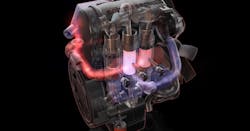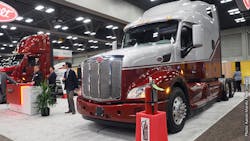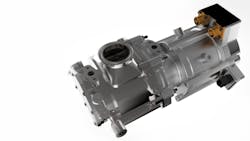A California project is working to produce a radically different commercial diesel engine that emits much less, burns less fuel, and produces the same or more power as a conventional diesel powerplant in smaller-displacement package.
This on-road demo eventually will see this new engine under the hood of a Peterbilt Model 579. At the heart of the project is a 10L two-stroke opposed piston engine from Achates Power.
A traditional four-stroke engine has a single piston per cylinder being driven up and down as fuel and air come in, are compressed and are ignited, and exhaust gases are then pushed out. Valves, injectors, nozzles and spark ignition typically conduct that orchestra from the cylinder head above.
An opposed-piston engine is very different—two linked pistons push back and forth in each cylinder—and there's no cylinder head at all.
"Throughout the 20th century, when the utmost fuel, weight and volume efficiencies were required to propel aircraft, ships and vehicles, an unconventional type of compression ignition engine was used: opposed-piston engines," Achates states on its website.
The California Air Resources Board (CARB) provided $9 million to CALSTART, a clean transportation catalyst group that's managing the project. Achates Power will provide the engine and is leading a project team of Aramco Services, BASF, Corning, Dana, Delphi, Eaton, Faurecia, Federal Mogul, Honeywell and Litens joined also by the Southwest Research Institute.
This 10L opposed-piston diesel will be roughly equivalent to a 15L four-stroke, according to Mihai Dorobantu, director of technology planning and government affairs at Eaton Vehicle Group. Eaton technology will manage the precise airflow needed for the opposed-piston engine with a Twin Vortices Series (TVS) air pump/ charger—belt-driven so far in this demo, though there are other options—and the company is developing a new TVS component for the purpose.
Achates was formed in 2004 and has been working on opposed-piston engines for the U.S. military. Achates and Cummins Inc. have been collaborating on a new family of engines for the U.S. Army since 2014 and are slated to build, test and commercialize new products in that vein within about the next three years.
The opposed-piston engine design is scalable and efficient, according to Achates, and could be used to make engines for that effort anywhere from a 4.0L 300 hp. to a 20.0L 1,500 hp. unit.
Some claimed benefits of an opposed-piston engine vs. a conventional design include:
—Lower fuel consumption. Opposed-piston engines are said to wring more power out of less displacement and fuel burned with their more efficient design.
—Lower emissions. The CALSTART demo is targeting CARB's lowest Ultra-Low NOx standard while also lowering CO2 emissions "well below today's best trucks," according to Achates, up to 15-20% less carbon emissions than required under current greenhouse gas standards.
—Simplified engine and components with cylinder head/ valvetrain eliminated. It could translate to less friction, loss and overall cost for this type of internal combustion engine as well as related benefits like less maintenance.
About the Author
Aaron Marsh
Aaron Marsh is a former senior editor of FleetOwner, who wrote for the publication from 2015 to 2019.


